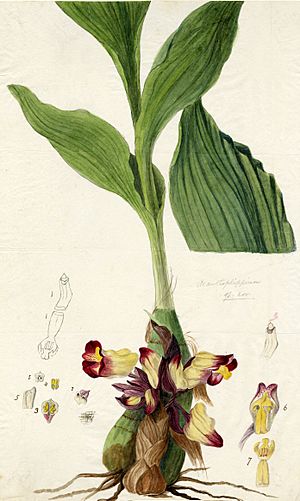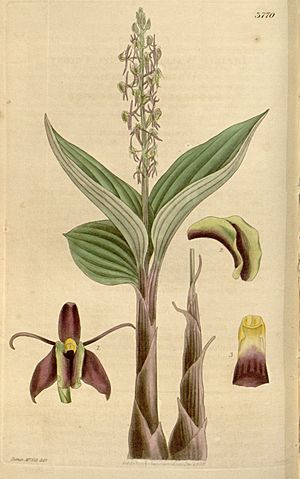Anna Maria Walker facts for kids
Quick facts for kids
Anna Maria Walker
|
|
|---|---|
| Born | 1778 |
| Died | 1852 (aged 73–74) Mangalore, India
|
| Resting place | St Paul's Church graveyard, Mangalore |
| Nationality | British |
| Known for | botanist, plant collector, botanical artist |
| Spouse(s) | George Warren Walker |
| Children | seven |
| Parent(s) | Colonel Robert Patton and Constantia Adriana Sally Mapletoft |
Anna Maria Walker (born Patton) (around 1778–1852) and her husband Colonel George Warren Walker (1778–1843) were Scottish plant experts. They explored and collected many plants in Ceylon (now Sri Lanka) between 1830 and 1838.
Famous botanists like Sir William Jackson Hooker named several types of ferns and orchids after them. Anna Maria was also a very talented artist. She drew many beautiful pictures of orchids. Some plants named after them include Vanilla walkeriae, Liparis walkeriae, and Thrixspermum walkeri.
Contents
About Anna Maria and George
Anna Maria's Early Life
Anna Maria Patton was likely born in 1778 in Kinaldy, Fife, in Scotland. She was one of 17 children! Her father, Colonel Robert Patton, worked for important leaders in India. He earned enough money to buy Kinaldy, their family home.
In 1797, her family moved to Edinburgh. Anna Maria and her sisters went with their father when he became Governor of the island of St Helena in 1801. There, she might have learned about plants and art from the island's botanist, William John Burchell. Later, Anna Maria traveled to India, where she married Captain Walker. In 1819, they moved to Ceylon. In 1820, Anna Maria was probably the first European woman to climb Adam's Peak, a famous mountain in Ceylon.
George Warren's Military Career
George Warren Walker was born on March 25, 1778, in Yorkshire, England. He joined the British Army in 1799. He became a Lieutenant in 1801 and went to India.
He fought in several wars, including the Anglo-Maratha War and the Anglo-Gurkha War. On July 20, 1809, he married Anna Maria Patton in India. In 1819, he was made Deputy Adjutant General of Ceylon. The Walkers lived there until 1838, except for a break in Britain. George later became a Brigadier and Major General. He died on December 4, 1843, in Madras, India.
A Break in Edinburgh
After about six years in Ceylon, the Walkers took a break and returned to Britain. They rented a house in Edinburgh, close to the Royal Botanic Garden. They wanted to find a hobby for when they returned to Ceylon.
They met important plant experts there, like Robert Graham and William Jackson Hooker. These meetings likely inspired them to collect plants. They decided to send plant samples, seeds, and living plants back to the Edinburgh Botanic Garden. Colonel Walker even told Anna to learn botanical drawing. This way, she could draw delicate plants before they faded.
Exploring and Collecting in Ceylon
The Walkers soon began sending many plant materials back to Edinburgh and Glasgow. They sent letters with their valuable donations, which depended on the kindness of ship captains.
The Walkers mostly lived in Colombo, the main British city on the coast of Ceylon. But they often visited Kandy, which was in the middle of the island and had many interesting plants. At this time, many new roads were being built. This made it easier to reach new areas for collecting plants, especially around the hill station of Nuwara Eliya.
The Walkers went on two big trips. In 1833, they took a two-week trip to climb Adam's Peak. In 1837, they went on a nine-week tour around the southwest part of the island. Mrs. Walker sent journals about both trips to Hooker, who published them.
Studying the Plant Collections
Hooker and Graham were very busy. So, they asked another botanist, George Arnott Walker-Arnott, to study the Walkers' first plant collections. He wrote about the new species they found in a book called Pugillus Plantarum Indiae Orientalis.
Many new species were named after Colonel Walker. These include Desmodium walkeri, Sykesia walkeri, and Plectranthus walkeri. Arnott also wrote about the beautiful Impatiens plants the Walkers discovered. Other botanists also studied the Walkers' plants. For example, Christian Nees von Esenbeck studied the Strobilanthes plants, which the Walkers found interesting because they flower all at once after many years.
The Walkers' friend, Robert Wight, also published some of Mrs. Walker's drawings. He even named new species based on their plant samples. Anna Maria Walker did not publish any books herself, except for her two journals. She might have been sad that Hooker did not use her very accurate orchid drawings.
Later Years in India
General Walker spent his last two years in the plains of northern India. Their plant collecting slowed down. They did take a trip to Mussoorie in the Himalayan foothills in 1841. They sent plants from there to Hooker, but he did not publish anything about them.
After General Walker died, Anna Maria stayed in India. Four of her seven children lived there, working in the military or government. She spent her last days in Mangalore, India, with her son Warren. She died there at age 74 on September 8, 1852. Her tomb can still be found in the graveyard of St Paul's church.
Images for kids
See Also
 In Spanish: Anna Maria Walker para niños
In Spanish: Anna Maria Walker para niños





